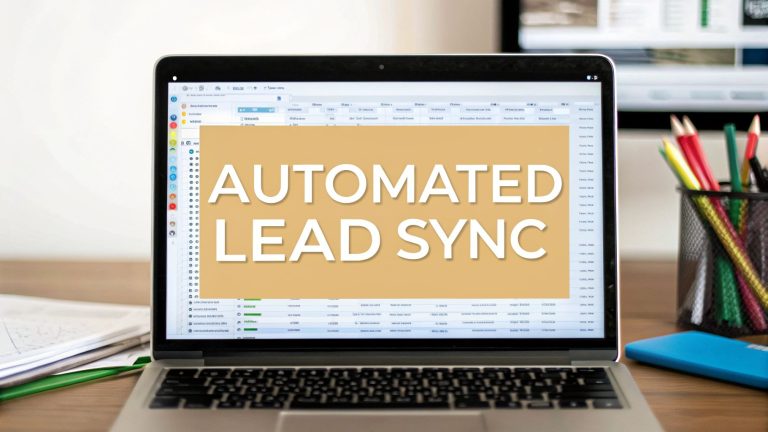How to Improve Team Productivity for Modern Teams
Trying to boost team productivity with old-school hacks just doesn’t cut it anymore. It's time for a new playbook—one that focuses on clear communication, smart technology, and a culture that values deep work.
This isn't about just another list of tips. It's a framework built to tackle the real issues dragging your team down, from the endless digital noise to the slow creep of burnout. Let's dig in.
Why Old Productivity Hacks No Longer Work
Let’s be honest. Telling your team to "manage their time better" or "stop multitasking" feels completely out of touch with the way we work now. The game has changed, and that old advice is officially obsolete.
Productivity today isn’t just an individual sport; it’s a team game. And the whole system is often rigged against us. We're fighting a constant flood of notifications, the pressure to be online 24/7, and a work culture that often mistakes being "busy" for being effective. No personal life hack can fix a broken system.
The Real Barriers to Team Productivity
The biggest roadblocks slowing your team down are usually hiding in plain sight. It’s not about a lack of effort—it’s about a lack of clarity, support, and focus.
Here’s what you’re really up against:
- Digital Overload: The endless pings from Slack, email chains that never die, and a dozen different project management tools create a state of what I call "continuous partial attention." No one can do their best work that way.
- Creeping Burnout: An "always-on" culture is a recipe for disaster. It blurs the lines between work and life, leading to total exhaustion and a team that’s just going through the motions.
- Vague Priorities: When everything is a top priority, nothing is. Your team ends up spinning their wheels on low-impact tasks because they don't have a clear North Star.
This isn’t just a morale problem; it’s hitting the bottom line. Hard. A huge factor killing productivity is employee engagement, which has tanked to a mere 21% globally. This trend, which many call 'quiet quitting,' has led to a staggering $438 billion in lost productivity. You can find more employee engagement statistics on archieapp.co.
The goal is to shift from a culture of constant motion to one of meaningful progress. This requires a fundamental change in how we think about work, communication, and the tools we use every day.
To really fix this, we have to look past the surface-level quick fixes. This guide is built on a modern framework designed for how teams actually work today. It all boils down to three core pillars that get to the root of the problem and unlock your team's true potential.
Clarify Communication and Define Expectations
Let's be honest: ambiguous goals and messy communication are silent killers of team productivity.
When your team spends more time digging through Slack channels and email threads for information than actually doing the work, you're not just losing hours. You're killing momentum and morale. The fix is to build a communication structure that creates clarity, not chaos.
This all starts with creating a single source of truth for every project. We've all been there—the marketing campaign where one person has the key assets in their email, another has the brief in a private doc, and critical feedback is buried 50 messages deep in a chat. This digital scavenger hunt is a massive waste of time.
A centralized project board in a tool like Asana or Trello solves this almost overnight. By making sure all tasks, deadlines, files, and stakeholder feedback live in one accessible place, you get rid of the guesswork. I once saw a sales team cut their new-hire onboarding time by 30% just by creating a crystal-clear, centralized hub for all their training materials and sales collateral.

Establish Your Communication Playbook
Having the right tools is only half the battle. You also need clear rules of engagement.
A communication protocol is just a simple guide that tells everyone which tool to use for specific needs. This isn't about being rigid; it's about being intentional and cutting through the digital noise. In fact, teams that get this right can boost their productivity by up to 25%.
Creating a simple framework prevents that classic frustration of sending an urgent email that goes unread for hours or dropping a critical decision into a busy chat channel where it gets completely lost.
Choosing the Right Tool for the Job
To avoid confusion and constant context-switching, a simple guide can make all the difference. Here’s a quick-start table you can adapt for your own team.
| Communication Need | Recommended Tool | Why It Works |
|---|---|---|
| Urgent Issue | Phone Call or Direct Message | Provides an immediate, real-time response when a project is blocked or a crisis hits. |
| Quick Question or Update | Team Chat (e.g., Slack) | Perfect for fast, informal check-ins that don't require a lengthy discussion or formal record. |
| Formal Decision or Detailed Brief | Email or Project Management Tool | Creates a permanent, searchable record for important information, feedback, and approvals. |
| Complex Problem-Solving | Video Call or In-Person Meeting | Allows for nuanced discussion and brainstorming that’s nearly impossible to do effectively over text. |
This simple chart helps everyone default to the right channel, keeping communication efficient and organized.
Define Roles and Responsibilities Clearly
Nothing grinds a project to a halt faster than confusion over who owns what.
A simple RACI model is a game-changer here. It clarifies who is Responsible, Accountable, Consulted, and Informed for every major task. No more tasks falling through the cracks.
Think about a new product launch. The content marketer is Responsible for writing the blog post, but the marketing manager is Accountable for its final approval. The sales team is Consulted for their input, and the entire company is Informed once it goes live. This simple act of defining ownership stops duplicate work and the endless back-and-forth.
By clearly defining roles and communication channels, you empower your team to act with autonomy and confidence. They know exactly what's expected of them and how to move forward without waiting for permission at every step.
Beyond individual clarity, strong team alignment is what truly separates good teams from great ones. When everyone is pulling in the same direction, clear communication becomes the engine of your team’s success. To dig deeper, check out Why Team Alignment Is a Startup's Greatest Competitive Advantage.
Use Technology and Automation to Reclaim Time
Technology should be your team's biggest ally, not another source of digital headaches. When you find the right tools and set up smart automation, you don't just speed up tasks—you give your team back their most valuable resource: time. This isn't about chasing every shiny new app. It's about strategically fighting the slowdown caused by clunky, disconnected software.
The real goal here is to kill off the tedious, repetitive work that drains your team's energy and focus. Your sales team shouldn't be spending hours manually logging call notes when a CRM integration can do it instantly. Your marketing team shouldn't be building the same weekly reports from scratch when an automated dashboard can pull all that data for them.
From Manual Effort to Automated Workflows
Getting started with automation is way easier than you might think. Tools like Zapier or Make let you connect the apps your team already uses every day, creating simple "if-this-then-that" workflows. These small efficiencies add up fast, creating huge time savings and pushing team productivity through the roof.
Just look at how an automation platform can string different tools together to create a completely hands-off workflow.

This shows how a single trigger—like a new form submission—can kick off a whole chain of automated actions across multiple platforms, from creating a lead in your CRM to sending a quick notification in Slack.
Putting these systems in place moves your team from reactive data entry to proactive, high-value work. I once worked with a support team that automated their ticket routing process. Instead of someone manually assigning every single ticket, they built a workflow that sent tickets to the right person based on keywords. This one change saved the team over 10 hours a week.
The most productive teams are 242% more likely to use AI. Why? Because it automates mundane tasks and delivers insights in seconds, freeing people up to focus on creative and innovative work.
Vet New Tools to Avoid Digital Friction
Be careful, though. Adding new software without a clear purpose can completely backfire, creating more confusion than it solves. Before you introduce any new tool, run it through this simple checklist to make sure it’s going to be an accelerator, not an anchor.
- Does it solve a real problem? Is this tool fixing a specific, recurring issue that wastes time or causes frustration right now?
- Does it play well with others? Can it connect smoothly with the software you already depend on, like your CRM, project manager, and communication platform?
- Is it actually usable? Is the interface intuitive enough for the team to pick it up without weeks of training and disruption?
- Can it simplify things? Could this one tool replace two or more existing ones, decluttering your tech stack instead of complicating it?
Answering these questions first helps you avoid "tool fatigue" and ensures every piece of software you use has a clear job. This strategic approach is non-negotiable if you want to effectively streamline business processes and build a truly efficient operation. For a deeper dive, check out our guide on https://leadsavvy.pro/post/how-to-streamline-business-processes/.
AI assistants are another powerful layer to add. They can now auto-generate meeting summaries with clear action items, draft email responses, or even analyze sales data to spot trends you might have missed. By offloading these cognitive burdens, you free up your team’s mental bandwidth for actual strategic thinking. To see how different industries are putting this into practice, explore these real-world examples of business process automation.
Build a Culture of Deep Work and Well-Being
Sustained productivity isn't about grinding harder; it's about working smarter within a healthy, focused environment. The biggest wins don't come from individual life hacks. They come from company-wide shifts that protect your team's most valuable asset: their attention. High performance is a direct result of a culture that champions both deep work and genuine well-being.
This means you have to actively fight back against the modern workplace's culture of constant interruptions.

Seriously, the modern office is a minefield of distractions. Research shows that employees are interrupted roughly every 3 minutes. What’s worse, it takes about 23 minutes to fully get back on track after each one. When you do the math, it’s shocking. This is precisely why protecting focus isn't a "nice-to-have"—it's a non-negotiable. For a deeper look at these trends, check out the insights on rethinking productivity from eptura.com.
Protect Your Team’s Focus
One of the most powerful things you can do to boost productivity is to give people uninterrupted blocks of time to actually think and execute. Constant context-switching between emails, Slack pings, and back-to-back meetings makes any meaningful progress impossible. The only way out is to get intentional about how your team’s time is structured.
Here are a few focus-protecting strategies we've seen work wonders:
- No-Meeting Blocks: Designate specific times as sacred, meeting-free zones. A classic "No-Meeting Wednesday" can give everyone a predictable chunk of time to dive deep into complex projects without getting pulled away.
- Asynchronous-First Communication: Build a culture where not everything demands an immediate reply. Use shared documents for feedback and project management boards for status updates. This empowers people to respond on their own schedule, not someone else's.
- Clear Status Signals: Encourage everyone to use "Focus Time" or "Heads Down" statuses in your chat apps. It's a simple signal that tells colleagues to hold non-urgent questions, respecting boundaries without creating friction.
These small changes add up, sending a powerful message that your organization values thoughtful work over just being busy.
Prioritize Well-Being to Prevent Burnout
Let's be clear: a burned-out team is an unproductive team. Real productivity has to be sustainable, and that sustainability is built on well-being. As a leader, you can't just talk about it—you have to model it.
When managers are firing off emails at 10 PM or working through vacation, they're sending a loud message that work-life boundaries don't matter.
Long-term success is built on a series of well-paced sprints, not a single, never-ending marathon. When you prioritize your team's well-being, you're not just being kind—you're making a strategic investment in their long-term performance and loyalty.
Keep an eye out for the early warning signs of burnout, like growing cynicism, missed deadlines, or social withdrawal. Offer support before it starts to poison morale. This means having regular, candid check-ins that are about more than just project updates.
For sales teams, where the pressure is always on, these practices are absolutely critical. You can learn more in our dedicated guide on how to improve sales productivity https://leadsavvy.pro/post/improve-sales-productivity/. By respecting boundaries and promoting regular breaks, you build a resilient team that can perform at a high level, day in and day out.
Measure What Matters and Give Better Feedback
You can't improve what you don't measure. It’s an old saying because it’s true. But this isn't about micromanaging or tracking every single keystroke. To really boost your team's productivity, you have to stop focusing on busywork and start measuring what actually moves the needle.
Too many managers get stuck tracking "vanity metrics" like hours logged or the number of emails sent. Sure, those numbers might look good on a report, but they tell you next to nothing about whether you're winning. The real magic happens when you shift your focus to Key Performance Indicators (KPIs) that show the direct impact of your team's work.
From Vanity Metrics to Valuable KPIs
Let's get real about what effective measurement looks like. It’s about tracking outcomes, not just effort.
For a sales team, celebrating the number of calls made is a classic mistake. A much sharper KPI is the call-to-demo conversion rate. That tells you how effective those calls actually are. Similarly, a marketing team's success isn't just about publishing a bunch of blog posts; it's about the engagement rate and, more importantly, the leads generated from that content.
Switching your mindset transforms metrics from a surveillance tool into a powerful coaching instrument. If you want to dive deeper, our guide on how to measure marketing effectiveness can help you connect your team's daily activities to real business results.
Here’s a quick look at how to reframe your metrics for different roles:
From Vanity Metrics to Valuable KPIs
| Role | Vanity Metric (Avoid) | Effective KPI (Focus On) |
|---|---|---|
| Sales Rep | # of calls made | Call-to-demo conversion rate, Sales cycle length |
| Marketer | # of posts published | Leads generated per channel, Content engagement rate |
| Support Agent | # of tickets closed | Customer Satisfaction Score (CSAT), First-contact resolution rate |
| Developer | Lines of code written | Cycle time (idea to deployment), Bug resolution time |
Focusing on the right KPIs gives you a clear, honest picture of performance, making it easier to spot where your team is excelling and where they might need a hand.
The most productive conversations happen when data provides the "what" and empathy provides the "how." Use metrics to identify performance gaps, but use human connection to understand the story behind the numbers.
This isn't just theory. When you invest in the right tools and actually train your team to use them, the productivity gains are tangible.

The data is clear: high tool adoption paired with proper training is directly linked to a real jump in team output.
Turning Data Into Constructive Conversations
Just collecting data isn't enough. The real value comes when you use those insights to have better, more helpful conversations with your team. Generic feedback like "good job" or "we need to step it up" is completely useless. To be effective, feedback needs to be specific and backed by data.
Instead of saying, "Your response times are slow," try this:
"Hey, I noticed our average customer ticket response time went up by 15% this quarter. Let's pull up the dashboard together and see if we can figure out where the bottlenecks are."
This approach is a game-changer. Why?
- It takes personal opinion out of it. The conversation is grounded in objective numbers, which helps lower defenses.
- It feels like a team effort. You're solving a problem together, not just delivering a critique from on high.
- It makes expectations crystal clear. The team knows exactly what success looks like and what they’re aiming for.
When you combine clear metrics with empathetic delivery, you build a culture where people are always looking for ways to improve. Feedback stops being something to dread and becomes a welcome chance to grow. That's how you build a team that isn't just productive, but one that's engaged, motivated, and pulling in the same direction.
Got Team Productivity Questions? We’ve Got Answers.
Even the best-laid plans run into roadblocks. When it comes to team productivity, the real wins come from tackling those day-to-day hurdles with practical, straightforward solutions. Let's dig into some of the most common questions managers are asking right now.
How Do You Actually Improve Productivity in a Hybrid Team?
This one trips up a lot of leaders. The secret is to stop tracking online hours and start measuring tangible outcomes. It's a mindset shift.
When your team is split between the office and home, asynchronous communication is your best friend. Get everyone on a shared project management platform like Trello or Asana and make it the single source of truth for all projects. This keeps everyone aligned, no matter when or where they’re working.
You might also try setting "core collaboration hours"—say, 11 a.m. to 2 p.m.—where everyone is available for quick syncs or critical meetings. Outside of that window? Total flexibility. The goal is to judge performance on what gets done, not who is online.
The best hybrid teams are built on two things: trust and clarity. When everyone knows what a win looks like for their role and where to find the info they need, location becomes a non-issue.
Productivity Is Tanking. What’s the First Thing I Should Do?
Before you start throwing solutions at the wall, you have to figure out the real problem. Don't guess. The fastest way to get answers is to just ask your team what's getting in their way.
You could run a simple, anonymous survey or just have candid one-on-one chats. Try asking questions like:
- "What's the one thing that slows you down every single week?"
- "Are our current tools helping you or just adding another step?"
- "Do you feel like you have enough uninterrupted time to actually focus?"
Once you see a pattern—maybe it's too many meetings, clunky software, or shifting priorities—implement one small, targeted change. If meetings are the culprit, pilot a "No-Meeting Wednesday." A quick, visible win like that builds the trust and momentum you need for bigger improvements down the line.
Can Having Too Many Tools Actually Hurt Performance?
Oh, absolutely. It's a classic case of "tool fatigue," and it's a massive productivity killer. When your team has to constantly jump between a dozen different apps that don't talk to each other, they spend all day context-switching. That drains mental energy and completely shatters focus.
The fix? Do a tool audit. Figure out which apps are mission-critical, which ones have overlapping features, and which ones you can cut loose.
And before you add anything new to your tech stack, make sure it solves a specific, painful problem and integrates smoothly with what you already use. Every tool should be there to remove friction, not create more of it.
Speaking of removing friction… LeadSavvy Pro automates your Facebook Lead Form submissions directly to your CRM or Google Sheets, so you can stop wasting time on manual downloads. Get instant notifications and empower your team to act on new leads in seconds. Start for free at https://leadsavvy.pro and see the difference.







